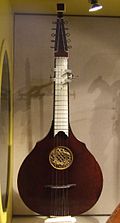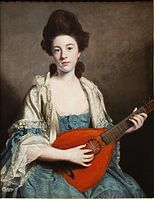English guitar
 English guitar made by William Gibson in 1772 | |
| Classification | String instrument (plucked) |
|---|---|
| Hornbostel–Sachs classification | 321.322 (necked box lute) (Chordophone with permanently attached resonator and neck, sounded by a plectrum) |
| Developed | 18th century |
| Related instruments | |
|
List
| |
The English guitar or guittar (also citra), is a stringed instrument – a type of cittern – popular in many places in Europe from around 1750–1850. It is unknown when the identifier "English" became connected to the instrument: at the time of its introduction to Great Britain, and during its period of popularity, it was apparently simply known as guitar or guittar. The instrument was also known in Norway as a guitarre and France as cistre or guitarre allemande (German guitar). There are many examples in Norwegian museums, like the Norsk Folkemuseum and in British ones, including the Victoria and Albert Museum. The English guitar has a pear-shaped body, a flat base, and a short neck. The instrument is also related to the Portuguese guitar and the German waldzither.
Early examples had tuning pegs (similar to a violin or lute), but many museum examples have what are commonly referred to now as Preston tuners, an innovation that appears closely linked with the instrument.
Tuning[]
It usually had ten strings in a repetitive open C tuning,[1] of which the highest eight are paired in four courses (doubled strings),
- C E GG cc ee gg
The English guitar may have influenced the development and tuning of the Russian guitar, which has seven strings tuned to open G in thirds (G⸜–B, B–D, g–b, and b–d⸝) with two in fourths (D⸜–G⸜, and D–g):
- D⸜, G⸜, B, D, g, b, d⸝.
Gallery[]

1766, England.Mrs. Robert Gwillym playing an English guitar, painting by Joseph Wright of Derby.

1762, England. Painting by Sir Joshua Reynolds of Mrs. Froude playing an English guitar or cittern.
See also[]
References[]
| Wikimedia Commons has media related to English guitar. |
- ^ Annala, Hannu; Mätlik, Heiki (2007). "Composers for other plucked instruments: Rudolf Straube (1717-1785)". Handbook of Guitar and Lute Composers. Translated by Backman, Katarina. Mel Bay. p. 30. ISBN 978-0786658442.
- Repetitive guitar-tunings
- Non-Spanish classical guitars

